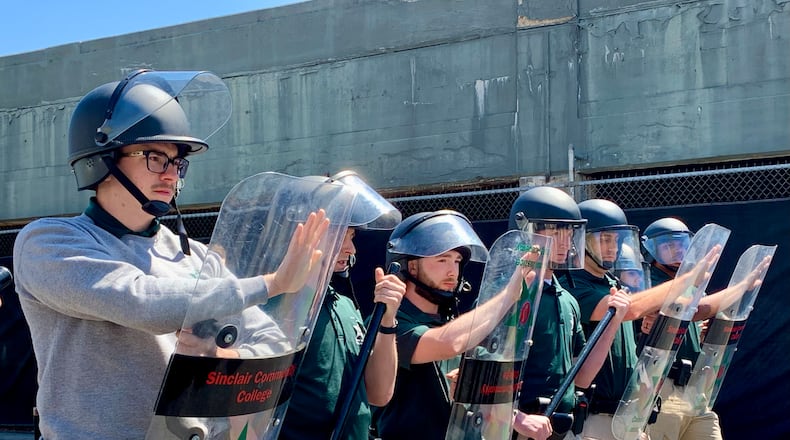Cadets stand in a line, with two of them at any given time serving as squad leaders. The leaders’ job is to communicate with each other and a supervisor, who at this point is Commander Jeff Thomas, the day’s instructor and the commander of this crop of cadets for the entire academy.
The cadets move across the lot in a line, wedge, and then what’s called a lateral support formation, which is used to keep people from filtering in behind the front line.
Thomas and Kettering officer Jon McCoy act as protesters and rioters, using everything from passive resistance with a phone out to record, to actively pushing against the wall of riot shields.
Cadets also practice gas mask deployment, wherein every other cadet steps behind the person to their right (or left as the case may be) takes a knee, and dons a gas mask before returning to the line to cover the previous person.
Crowd control is a “low-frequency, high-risk” event. Cadets are taught the responsibility of law enforcement is to objectively discern when lawful protest becomes unlawful. The goal is to protect lawful activity while identifying — and isolating — unlawful behavior.
It can turn on a dime. Protests in downtown Dayton after the killing of George Floyd by Minneapolis police escalated when protesters threw rocks and bottles. A Dayton police officer was injured. Police said they used “chemical munitions” when protesters became violent. Protesters claimed police used chemicals first, then protesters responded with rocks and bottles.
Police have donned riot gear several times in recent years at the University of Dayton. Several St. Patrick’s Day celebrations have gotten out of hand and led to clashes with police including thrown objects, property damage and arrests. In 2015 a Dayton police officer was hurt when he was hit in the head with a full beer can after a celebration of the Flyers’ NCAA run led to a civil disturbance. In 2020, police used riot control methods when a large disorderly crowd formed after UD announced student housing would close because of COVID-19.
Dayton also has a growing “hooning” problem, which has the potential to turn into something worse. All it takes is one person to do something stupid.
‘Shut up, hold the line’
From the first day of the academy, cadets practice formation on Monday, Wednesday and Friday morning before class, lining up with clean and tidy uniforms, shined shoes, and orderly equipment.
They are taught managing civil disorders is a balance between people’s First Amendment rights, and the need to protect public safety and property.
Rioters are most often charged with disorderly conduct, failure to disperse, rioting, inciting violence, or aggravated rioting, if pre-meditated.
“Charging (people) is for white shirts and above. Your job for the first five years of your career is to shut up, hold the line, and do as you’re told,” Thomas said.
Peace officers cannot be influenced by the position of the protesters, political affiliation, or any demographic factors of those expressing their first amendment rights.
After the event, every use of force is documented.
“While in uniform, you don’t have an opinion. You are neutral,” Thomas said.
KKK rally
An example of this was in 2019, when a Ku Klux Klan group organized a rally in downtown Dayton. On the day of the Klan rally, nine Klansmen showed up, to between 500 and 600 counter-protestors.
Academy trainers were vocal about their disdain for the KKK — noting the irony that in photos of the event, one of the Klansmen can be seen wearing Jordans — but stressed it was still the responsibility of local police to keep them safe.
Several months of planning and $650,000 later, “it went off without a hitch,” Thomas told cadets. No arrests were made.
Credit: Marshall Gorby/Staff
Credit: Marshall Gorby/Staff
McCoy was one of the officers during the KKK protest whose job was to stand in the building behind the Klansmen and pull them inside if the crowd broke the fences across the street.
The Klan rally is a rare example of when organizers of a demonstration communicate with a municipality ahead of time — a luxury in police work — but regardless of affiliation, early and consistent communication between protesters and police can help facilitate people’s right to assembly, and deter riots from ever happening.
“Fall back on your crisis intervention skills,” Thomas said. “Use your talking and de-escalation to stop things before it gets started.”
About the Author






